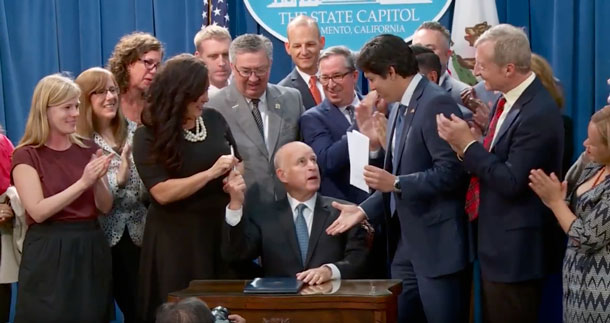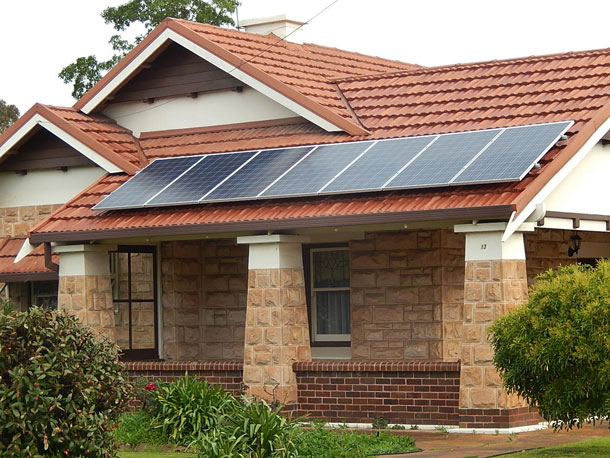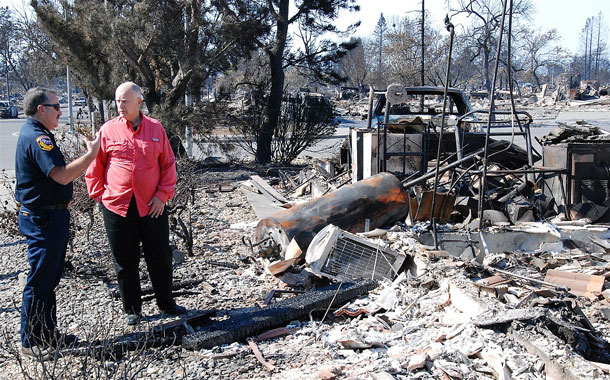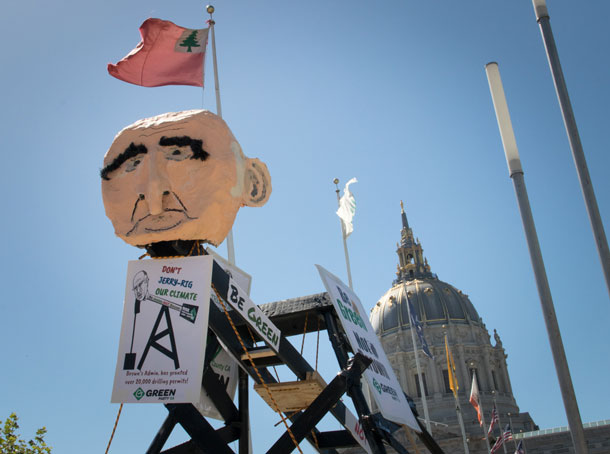California Moves Toward Carbon-Free Economy
Air Date: Week of September 14, 2018

On September 10th, California Gov. Jerry Brown signed SB100, a law that puts the state on a path towards carbon-free electricity generation by 2045. (Photo: California Senate Democrats, Youtube)
A new law puts California on a path to carbon-free electricity generation by 2045. And leaders from around the world recently convened in San Francisco at the Global Climate Action Summit organized by the state’s Governor, Jerry Brown. Host Steve Curwood and Jared Blumenfeld, former EPA Regional Chief, discuss the state’s swift progress towards decarbonizing its growing economy and why some citizen activists say even stronger action is needed.
Transcript
CURWOOD: From PRI and the Jennifer and Ted Stanley Studios at the University of Massachusetts Boston, this is Living on Earth. I’m Steve Curwood.
BASCOMB: And I’m Bobby Bascomb.
It has been a big week for weather and the climate. This is the second year in a row for monster hurricanes. A killer storm named Florence is laying waste to the home ground of millions of Americans as we record this. And later in the broadcast we’ll continue our series looking back at the impact of hurricane Maria in Puerto Rico. The growing frequency of major hurricanes is linked to climate change, and recently the UN Secretary General, Antonio Guterres, warned the world is close to a tipping point of runaway climate disruption. He called on world leaders to act before 2020, declaring climate change is “the defining issue of our time and we are at a defining moment.”
The UN chief’s call for action was echoed by the Global Climate action summit in San Francisco.
[SOUNDS OF MARCH]
MARCHERS CHANTING: Rise up, all the people of the world, all the people of the world, rise up!
CURWOOD: California’s robust bi-partisan approach resulted in meeting key goals to cut global warming gases four years earlier than state law required. And the Golden State recently enacted a law that calls for 100 percent carbon-free energy by 2045. Former EPA regional administrator and Podship Earth host Jared Blumenfeld joins us now. Welcome to Living on Earth!
BLUMENFELD: Thank you. It's great to be here. It's an honor.
CURWOOD: Why do you think California is the epicenter of climate action in the United States?
BLUMENFELD: So, California is kind of where the environmental movement started, Steve. In many ways we had the spill in 1969 off Santa Barbara. We have still the worst air quality in the United States in LA and in our Central Valley, and the other thing is that people move to California because they love the outdoors. So, when you combine all these things, you've got big environmental challenges and a lot of opportunity to spend time in nature, this is a big issue for people. People care about it viscerally. They really want to do things in their everyday life, and they want to make sure that politicians are doing things, to bring the reality of climate reduction and climate adaptation to the center of the political debate. And there's a lot of thought and attention that's been paid to, how do we transition to a clean economy, how do we transition to a carbon zero economy, and make our economy strong? So, California is now the fifth largest economy in the world, it overtook the United Kingdom where I grew up -- I think maybe because they passed Brexit -- and that gives us a pretty good bully pulpit. And Jerry Brown this week has taken advantage of that at the Global Climate Action Summit. Leaders came from around the world and they really committed to up their game, and I think they wouldn't have done that if California hadn't been in a position of leadership.
CURWOOD: So, now how significant is California's new legislation, that Governor Jerry Brown has now signed? It calls for the state to receive all of its electricity from carbon-free sources by 2045.

Activists covered San Francisco’s UN and Civic Center Plazas in nearly 50 murals on September 8, 2018, during the Rise for Climate, Jobs, and Justice March. (Photo: Peg Hunter, Flickr CC BY-NC 2.0)
BLUMENFELD: It's a huge deal. I mean, saying you're going to go 100 percent carbon free by 2045 is significant. And certainly because we're such a large state with 40 million plus inhabitants, and in terms of Silicon Valley and all the things that California does, I think it says to the world it can be done, this is about leadership right now. And it sends a strong message to the rest of the world who kind of see the United States as a monolith -- they just see it as Trump and a White House that is really anti-environmental -- and this is sending a very different message, which is states like California are taking leadership, they will make a difference and they'll help us achieve the goals of the Paris Agreement.
CURWOOD: So, talk to me about how California is going to meet this ambitious goal of being carbon-free when it comes to energy production?
BLUMENFELD: So, Steve, we're already on our way, so this isn't kind of out of the blue. California is not just suddenly saying, oh my God, we need to do something. California has been on a path to get to 50 percent renewable energy. At the moment if you include large-scale hydro power, we're at about 40 percent, so we're on the way. And part of this was saying the utilities are having actually a pretty easy job of getting us to 50 percent, we need to up our game. But it isn't going to be easy.
One of the reasons is that if you think about solar, in particular, the peak amount of solar energy comes at midday at about 1 pm. In California we use the most amount of energy in our day at about 7 pm. And lots of times now in our year we're pushing energy to Arizona and Nevada -- we're actually paying them to take it -- because our grid at that time can't handle all the energy. At the same time we need energy later in the day. So, energy storage is really going to have to become a reality for California even to get to 60 percent renewable energy. One form that could take, Steve, would be through splitting water molecules into hydrogen and then storing that hydrogen and then using it at a different time of the day. Batteries are also a different form of storage that people are looking at, but at the moment I think hydrogen the one that people are betting on in terms of storage.
CURWOOD: Now, of course, hydrogen, you have two choices. You could burn it in today's combustion engine or you could put it in a fuel cell, and you would...?
BLUMENFELD: ...put it in a fuel cell. Primarily because it's more efficient. And it basically, if you think about hydrogen cars that are now on the road, Steve -- and there's more and more of them in California -- they are an electric vehicle, but rather than having a battery they have a fuel cell, and that fuel cell is powered by hydrogen.
CURWOOD: OK. So, the goal for electricity production is to be carbon free by 2045. What about the rest of the energy that California uses?

In May, 2018, California became the first state to require all new homes to have solar power. The requirement goes into effect in 2020. (Photo: Michael Coghlan, Flickr CC BY-SA 2.0)
BLUMENFELD: So, when you look at our greenhouse gas emissions, the majority of what we still have is produced by the transportation sector. With more than 40 million Californians, they have 29 million vehicles and a million of those are heavy duty trucks, so the governor has also come out with a pretty audacious goal in the transportation sector of $5 million zero emission vehicles by 2030. In some ways that's going to be much more difficult to meet than the renewable energy goals in that you really have to change hearts and minds of individual drivers, and what he said is we're going to have to build about $250,000 electric vehicle charging stations in the state. That's a massive infrastructure project and one of the benefits that California has, which kind of ties this all together, is that we have a cap and trade regime.
So companies, industries that want to pollute greenhouse gas emissions have to pay, and the total amount in the state keeps coming down and the permits get more and more expensive. So about $6 billion dollars, Steve, has already gone into this fund, the greenhouse gas reduction fund, and the revenue source is cap and trade. So, the governor has said we're going to put at least $1.5 billion dollars into this charging station network, we're going to really push the heavy duty vehicles to switch to things like electric vehicles like the Tesla long-haul vehicles that they're making, for instance. So, yeah, there's money behind these promises and I think they're going to get there. That being said, California still has the worst air quality of any state in the nation, and four out of five Californians live in a county that has air that does not meet federal standards. So, we've got this dichotomy between really forward-moving stuff and, at the same time, really stubborn challenges for our generally low income and minority communities in this state.
CURWOOD: So, let's just say that Governor Brown came to you tomorrow -- or maybe his successor, it could take a little while -- and said, "Jared Blumenfeld, you are now California's energy czar". What kind of policies would you put in place to keep California moving towards decarbonizing its economy?
BLUMENFELD: So, the first thing, Steve, really is implementing what we've already agreed to. So, this governor has done an amazing job of setting some big audacious goals around energy independence and moving us away from fossil fuels. And really a lot of that is now in the details of implementing it. So, for instance, the building codes -- things that aren't particularly sexy -- but there's 100,000 homes built every year in California, there was a law that was just passed to make sure that solar panels are on every single one of them. But the building interior needs to really get more even more efficient than it is right now. We have appliances in our homes like gas hot water heaters. Gas has kind of been in this transition from coal to renewables, and natural gas in California has really played an important role.

CAL FIRE Chief Scott Brown briefs California Governor Jerry Brown as they survey the damage caused by the wildfires in Santa Rosa, California, on October 14, 2017. Climate change is linked to an uptick in wildfires in the state. (Photo: Capt. Will Martin, Army National Guard)
But if we're going to reach these goals of getting rid of carbon in our environment, we really need to tackle things like hot water heaters in our homes. They're ubiquitous, there are lots of solutions that would be better for those. Other kind of really cool things that don't naturally sound like energy, but do have to do with carbon, are agricultural policy. So, California grows 25 percent of the fruits and vegetables for the entire nation, have a lot of farmland. That farmland could actually be used to absorb carbon from the atmosphere and improve the crops for farmers. So there's a lot of energy right now around these things, but unfortunately, Steve, things like wildfires -- forests in California used to be a place that absorbed carbon from the atmosphere and now they're a net emitter of carbon because they're burning. So, we're in a really difficult time when it comes to the state's ability even to meet its greenhouse gas reduction target.
CURWOOD: So, as the Global Climate Action Summit was revving up, I understand you went to the Rise for Climate March in San Francisco. What was the mood there?
BLUMENFELD: Steve, I’m not really a march-goer! It took kind of a big push to get me out the door to go to the march, but once I was there, I mean there was amazing energy. People were just super motivated to do something around climate change and minds have changed, but really more importantly hearts have changed, all across the political spectrum. Because this doesn't really, I've talked to people whose houses were burned down, Republicans in the state, and they're like this is not a political issue anymore. When your house is burnt down, when you're covered by a mudslide, when your house gets knocked over by a hurricane, it really ceases to be a political issue pretty quickly, so I think there is a coming together. One of the cool parts of the march was that there weren't any speakers. So, normally you’ve got these talking heads and kind of people with all these egos telling you what you should and shouldn't do.

“Don't ‘Jerry-Rig’ our climate,” reads an effigy of California Governor Jerry Brown. Some activists who participated in the Rise for Climate March called out the Governor for granting more than 20,000 drilling permits. (Photo: Peg Hunter, Flickr CC BY-NC 2.0)
This was just people out on the street. There was marching bands. One of the interesting things was that people were saying, Jerry Brown's not doing enough, he really needs to keep the oil in the ground and they were saying that there's been a large increase on his watch of oil permits, and we need to make sure that the transition to a carbon free economy is just and equitable. Yeah, it's great to have cap and trade, but, you know what, they're buying permits to pollute in low-income minority communities and that's not OK. So, making this whole thing work for everyone in California I think is really important.
CURWOOD: Jared Blumenfeld is a former regional administrator of the EPA, and host of the new podcast, Podship Earth.
BLUMENFELD: I wanted to have conversations with people that it wasn’t about Trump, it wasn’t about politics. It’s really about why this fly fisherman on the McCloud River loves fishing. And, is he an environmentalist? Absolutely. Does he see himself as an environmentalist? Absolutely not. So we’ve kind of narrowed the tent of what it means to be an environmentalist. The goal of Podship Earth is to open it back up and say – we’re all part of nature, nature is part of us, and if we love it, we will protect it.
Links
The text of SB-100, the new California law that requires 100% carbon-free electricity by 2045
Vox | “California Gov. Jerry Brown casually unveils history’s most ambitious climate target”
About the Global Climate Action Summit
Rise for Climate, Jobs & Justice
Digital Trends | “Hydrogen fuel cell vehicles are thriving in California”
Living on Earth wants to hear from you!
Living on Earth
62 Calef Highway, Suite 212
Lee, NH 03861
Telephone: 617-287-4121
E-mail: comments@loe.org
Newsletter [Click here]
Donate to Living on Earth!
Living on Earth is an independent media program and relies entirely on contributions from listeners and institutions supporting public service. Please donate now to preserve an independent environmental voice.
NewsletterLiving on Earth offers a weekly delivery of the show's rundown to your mailbox. Sign up for our newsletter today!
 Sailors For The Sea: Be the change you want to sea.
Sailors For The Sea: Be the change you want to sea.
 The Grantham Foundation for the Protection of the Environment: Committed to protecting and improving the health of the global environment.
The Grantham Foundation for the Protection of the Environment: Committed to protecting and improving the health of the global environment.
 Contribute to Living on Earth and receive, as our gift to you, an archival print of one of Mark Seth Lender's extraordinary wildlife photographs. Follow the link to see Mark's current collection of photographs.
Contribute to Living on Earth and receive, as our gift to you, an archival print of one of Mark Seth Lender's extraordinary wildlife photographs. Follow the link to see Mark's current collection of photographs.
 Buy a signed copy of Mark Seth Lender's book Smeagull the Seagull & support Living on Earth
Buy a signed copy of Mark Seth Lender's book Smeagull the Seagull & support Living on Earth

